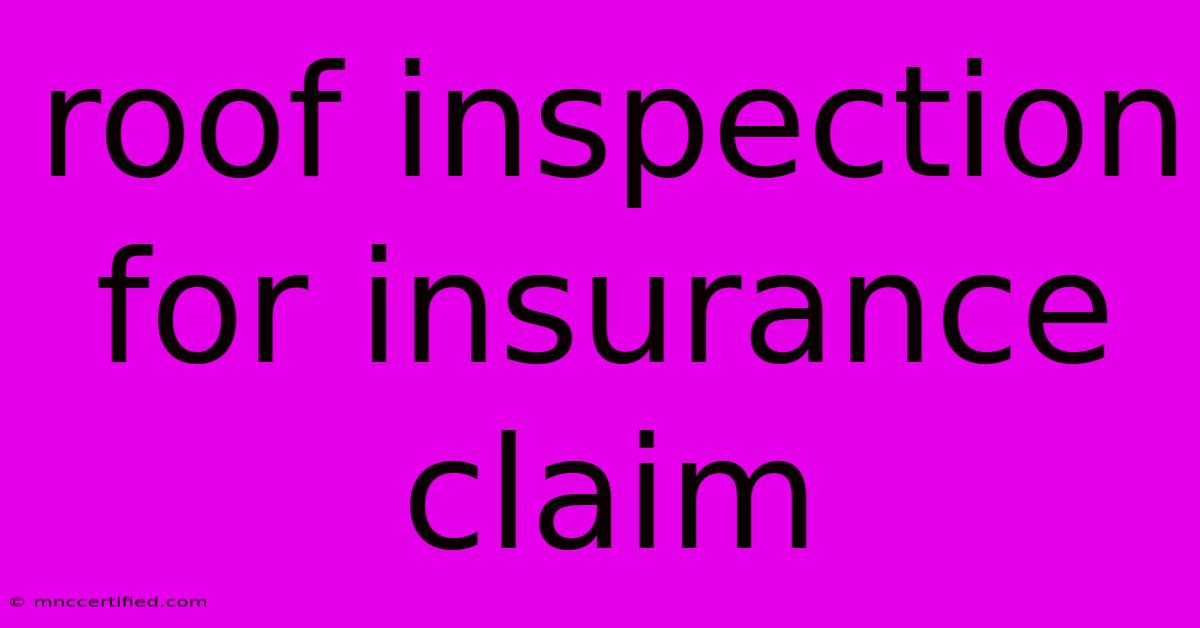Roof Inspection For Insurance Claim

Table of Contents
Roof Inspection for Insurance Claims: A Guide to Getting the Coverage You Need
Your roof is your home's first line of defense against the elements. When it's damaged, you need to act quickly to protect your property and ensure your insurance claim goes smoothly. A crucial step in this process is a roof inspection. This guide will explain why a roof inspection is essential for an insurance claim, how to find a qualified inspector, and what to expect during the process.
Why is a Roof Inspection Essential for an Insurance Claim?
Insurance companies require proof of damage to process a claim. A professional roof inspection provides this evidence, documenting the extent of the damage and its cause. This documentation helps your insurer:
- Determine the validity of your claim: The inspector's report will clearly show if the damage is covered by your policy.
- Assess the cost of repairs: The inspector's report will include details about the necessary repairs and their estimated cost.
- Prevent disputes and delays: Having a professional report can prevent delays and arguments with your insurer, as it provides objective evidence of the damage.
Finding the Right Roof Inspector for Your Insurance Claim
Not all roof inspectors are created equal. Choosing a qualified and experienced inspector is crucial. Here's what to look for:
- Experience: Choose an inspector with proven experience in evaluating roof damage for insurance claims.
- Certifications: Look for inspectors certified by reputable organizations like the National Roofing Contractors Association (NRCA) or the International Association of Certified Home Inspectors (InterNACHI).
- Insurance: Ensure the inspector has liability insurance to protect you from any potential issues during the inspection.
- Reputation: Research the inspector's reputation by reading online reviews and checking with previous clients.
- Transparency: Choose an inspector who clearly explains their inspection process and fees upfront.
What to Expect During a Roof Inspection for Insurance
A thorough roof inspection typically involves the following steps:
- Visual Inspection: The inspector will carefully examine your roof from both the ground and the attic, looking for signs of damage, wear, and tear.
- Documentation: The inspector will take photos and notes of the damage, including its location, severity, and potential causes.
- Report: The inspector will provide you with a detailed report outlining their findings, including recommendations for repairs and a cost estimate.
What to Do With Your Roof Inspection Report
Once you have the report, contact your insurance company immediately and provide them with a copy. This will expedite the claims process and ensure you receive the coverage you deserve.
Tips for a Successful Roof Inspection for Insurance
Here are some tips to make your roof inspection as smooth and informative as possible:
- Prepare your roof: Clear any debris or obstructions from your roof before the inspection.
- Communicate with your inspector: Tell the inspector about any known issues with your roof or any recent events that might have caused damage.
- Ask questions: Don't hesitate to ask the inspector any questions you have about the inspection or the damage found.
- Review the report carefully: Once you receive the report, thoroughly review it to ensure it accurately reflects the damage and includes a clear cost estimate.
Get the Coverage You Need
A professional roof inspection is an essential step in protecting your home and getting the insurance coverage you deserve after a roof damage incident. By following these tips, you can ensure your inspection is thorough and accurate, giving you the best chance of a smooth and successful insurance claim.

Thank you for visiting our website wich cover about Roof Inspection For Insurance Claim. We hope the information provided has been useful to you. Feel free to contact us if you have any questions or need further assistance. See you next time and dont miss to bookmark.
Featured Posts
-
Who Went Home On Dancing With The Stars Week 7
Nov 13, 2024
-
Bucks Beat Raptors Giannis Makes History
Nov 13, 2024
-
Dogecoin Climbs 20 Is This A New Trend
Nov 13, 2024
-
Deadpool And Wolverine Parental Guide
Nov 13, 2024
-
Kentucky Upsets Duke Citing Cramping Issues
Nov 13, 2024